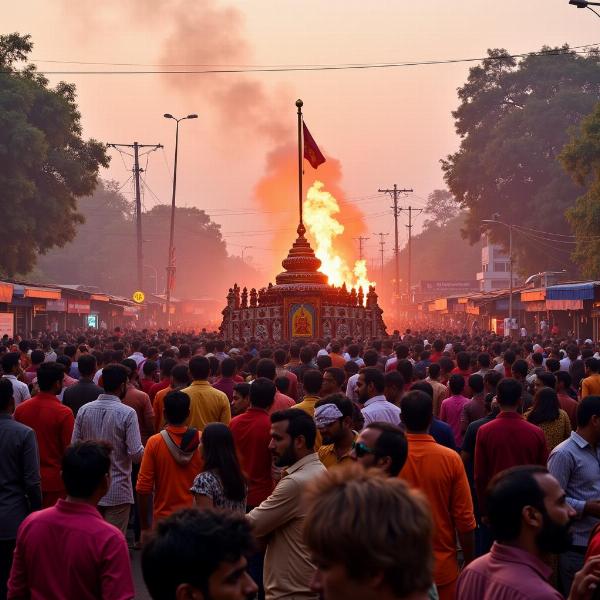Understanding the nuances of “dange” (danger) in Hindi is crucial for anyone navigating India’s diverse cultural landscape. Whether you’re a traveler, a business professional, or simply interested in the language, knowing how to express and interpret danger is essential. This article delves into the various meanings, synonyms, and cultural contexts associated with “dange” in Hindi, providing a comprehensive understanding of this important concept.
Exploring the Different Facets of “Dange” (Danger)
The word “dange” (दंगे) in Hindi primarily refers to riots or disturbances, often involving violence and unrest. It carries a strong connotation of public disorder and social upheaval. However, the concept of “danger” in Hindi extends beyond this primary meaning, encompassing various levels of risk and threat. Think about everyday situations, from crossing a busy street in Mumbai to navigating the complexities of Indian social etiquette. Each scenario presents its own unique set of “dange,” requiring careful consideration and understanding.
Synonyms and Related Terms for “Dange” in Hindi
Hindi offers a rich vocabulary to express different shades of danger. Words like “khatra” (ख़तरा) denote general danger or risk, while “jokhim” (जोखिम) emphasizes the possibility of loss or harm. “Bhayanak” (भयानक) signifies something terrifying or dreadful, highlighting the emotional aspect of fear. Understanding these nuances can help you communicate more effectively and accurately assess potential risks. For example, while “dange” might describe a riot, “khatra” could refer to a hazardous road condition.
Cultural Contexts of “Dange”
The concept of “dange” is deeply intertwined with Indian culture and society. Religious and political events can sometimes be flashpoints for “dange,” highlighting the importance of understanding the underlying social dynamics. Furthermore, traditional beliefs and superstitions also contribute to the perception of “dange,” influencing daily behavior and decision-making. For instance, certain days or times might be considered inauspicious, increasing the perceived “dange” associated with specific activities.
 People gathered for a religious procession in India
People gathered for a religious procession in India
Dange in Everyday Conversations: How to Use It Correctly
Knowing how to use “dange” appropriately in conversations is crucial for effective communication. Using the wrong word can lead to misunderstandings or even offend someone. For example, saying “Yahan dange hai” (यहाँ दंगे है) implies there’s a riot happening here, while “Yahan khatra hai” (यहाँ ख़तरा है) indicates a general danger. Choosing the right word ensures clarity and avoids unnecessary alarm.
What are the different words for “dangerous” in Hindi?
Understanding the nuances of “dangerous” in Hindi requires exploring its various synonyms. Words like “khatarnaak” (खतरनाक), “jokhimpoorn” (जोखिमपूर्ण), and “bhayanak” (भयानक) each carry slightly different connotations, allowing for precise expression of danger levels.
Conclusion: Navigating the Landscape of “Dange”
Mastering the concept of “dange” and its related terms provides invaluable insight into Indian culture and language. By understanding the nuances of danger and risk, you can navigate everyday situations with greater awareness and communicate more effectively. This knowledge not only enhances your language skills but also promotes cultural sensitivity and respect. Remember, being aware of potential “dange” is the first step towards mitigating risks and ensuring safety.
FAQ: Common Questions About “Dange”
-
What is the literal translation of “dange” in English? The literal translation of “dange” is “riots” or “disturbances.”
-
What are some other ways to express danger in Hindi? Other words include “khatra,” “jokhim,” and “bhayanak.”
-
How is “dange” used in everyday conversations? It’s typically used to describe situations of public unrest or violence.
-
What is the difference between “dange” and “khatra”? “Dange” specifically refers to riots, while “khatra” denotes general danger.
-
Why is understanding “dange” important in India? It helps navigate social situations and understand potential risks.
-
Are there any cultural implications associated with “dange”? Yes, religious and political events can be potential triggers for “dange.”
-
How can I learn more about Hindi vocabulary related to danger? Resources like dictionaries and online language learning platforms can be helpful.
Meaning-Hindi.in is your trusted partner for accurate and culturally sensitive Hindi translations. We offer a range of specialized translation services, including business and commercial document translation, legal and certified translation, technical and user manual translation, website and localization services, educational and academic document translation, and express translation services. Our expertise in various fields ensures precise and reliable translations tailored to your specific needs. Contact us at [email protected] or call us at +91 11-4502-7584. Meaning-Hindi.in is committed to delivering high-quality translations that bridge language barriers and foster effective communication.